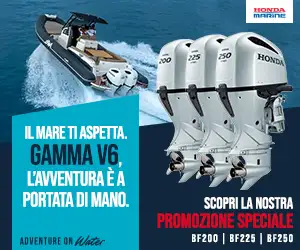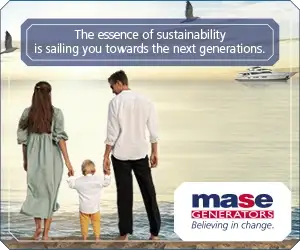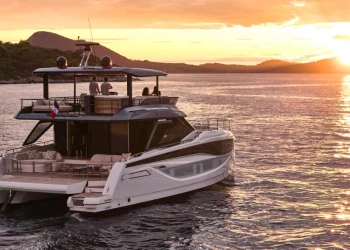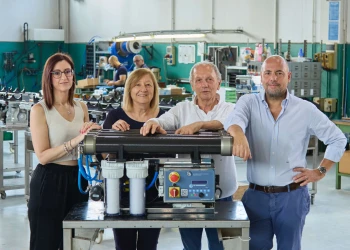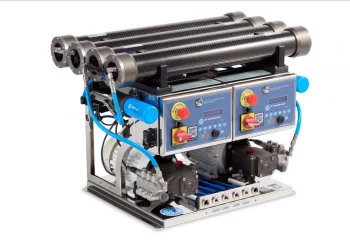
HP Watermakers celebrates 30 years of innovations focused on sustainability
Who knows if grandfather Defendente Grossi truly realised what he was starting when, shortly after the end of WWII, he started his business as a third-party turner in a garage on the outskirts of Milan. He made precision mechanical parts for a number of factories which were starting to take their first steps in Lombardy’s industrious capital. These precision mechanics meant that strict attention to the quality and precision of the processes was always required, to best respond to the customers’ requests.
Luciano Zucco joined the company in the 1970s. He later married Defendente Grossi's daughter, Valeria, and together they proceeded to structuring the company, which in the meantime had expanded and moved to Quinto Stampi, closer to Milan. The official name at the time was OMELF. The first collaborations with desalination plant manufacturers (and with many other production companies as well) started at the end of the 1970s.
“The 1980s and the first half of the 1990s were years of great growth,” says Gianni Zucco, co-founder of HP Watermakers. “The supply of mechanical parts for desalination plant manufacturers was an important part of our work, but, at the same time, we realised that there were enormous possibilities to improve and develop these machines, something that the manufacturers of the time had failed to understand. Hence the idea and desire to create our own machine, so we could develop it according to our ideas and technical skills. HP HIGH PRESSURE SRL was established in 1995, bearing the new HP Watermakers brand, and production started in a corner of the Quinto Stampi warehouse.”
“We struggled at first,” continues Gianni Zucco. “I still remember that in the first year we only sold two desalination plants and both were paid for with bad cheques... Fortunately, the other company was thriving, which meant it could financially support the start-up of HP Watermakers in its early days. And the rest is history - 30 years of history - and it proves that, with my parents and my sister Valentina, we got it right: today, HP Watermakers is at the forefront of the desalination sector, not only for boating, but also for the entire naval, civil and military sectors, for resorts, islands and communities.”
It is a classic story of Lombard entrepreneurship with intuitions and desire to grow that led to expansion beyond national borders, but it is also the story of a determined family that concentrated on its business. The company is now based in Zibido San Giacomo (also in the outskirts of Milan), in a 3,100 square metre site, where well over 400 desalination plants are produced per year, which is the production goal achieved so far.
International development was as important as expansion in Italy and there are now offices and dealers all over the world, managing commercial and technical activities. Currently, HP Watermakers has four direct subsidiaries, starting with Dubai in 2009, the Maldives in 2015 and South Africa in 2018, followed in 2021 by the opening of the subsidiary branch in Fort Lauderdale, Florida (USA). In addition to these offices, there are 56 dealers active in all continents of the world.
A history of innovation
The unleashing element behind the decision to create HP Watermakers, i.e. the desire to design and build something really innovative and revolutionary for a sector that had been “resting” too long on consolidated models, is also an element that shaped the history of the company.
“In 1997, the trend in the nautical world was clear: we were increasingly moving towards larger boats, where the desalination plant was becoming an essential on-board accessory,” recalls Gianni Zucco. “The models in production at the time, which had been the same for years, required continuous maintenance and had a number of reliability issues. Our first product, with automatic membrane washing, meant one big problem had been solved: it was no longer necessary for someone to periodically go down to the engine room and manually wash the membranes - an essential operation to prevent the desalination machine blocking. This led us to immediately retaining our first customers, because the ones who tried our machine did not change to a different product, giving us a major competitive advantage. This was important, because (among other things) at the beginning we were ostracised by our competitors who, moreover, continued to use the products produced by our other company.”
2002 was the year of a fundamental revolution, marked by the appearance of RP TRONIC. This is the only automation system for desalination plants that makes it unnecessary to go to the engine room to adjust the desalination plant, because the unit does so automatically and maintains the constant pressure required for desalination, so it is no longer a problem. When sailing, seawater can vary in salinity and temperature and this directly affects its density, and therefore the pressure inside the desalination plant. RP TRONIC solves these problems with a precision motorised automatic valve, which can automatically adjust the pressure to optimal levels inside the desalination plant so that the machine can work better and last longer.
The AMCS, the automatic membrane conservation system, made its debut only two years later. When a desalination plant is not used for some time, the bacteria in the water inevitably proliferate on the surface of the membrane, clogging it and reducing its production capacity. The AMCS works jointly with the automatic membrane washing and with RP TRONIC: it automatically dispenses a dose of sodium metabisulphite during the membrane washing phase, keeping the membranes functional for longer.
The 315-40 membranes were introduced in 2008. This exclusive measure allows for a smaller number of membranes in each machine, so it is possible to create more compact and lightweight desalination plants while also improving their energy efficiency, avoiding excessive costs when purchasing spare parts at a later date.
In 2017, Internet connection was added to the plants via BiBi, the first user interface for fully automatic desalination plants. BiBi allows operators to control each process of the desalination plant and verify each parameter, therefore helping with technical assistance for the desalination plant, notifying in advance of any malfunction, which it communicates through real-time notifications directly to the captains on their smartphone, to the technical team and/or to the nearest HP Watermakers authorised service. There are currently more than 400 connected machines.
“However, if I have to identify a real quantum leap, the honour definitely goes to Part-NET, the first user interface compatible with the Garmin, Raymarine, Furuno, Simrad, B&G and Lowrance plotters,” states Gianni Zucco proudly. “The desalination plant is connected directly to the plotters that automatically recognise it and this allows operators to control every process and verify every parameter directly from the yacht's bridge. It is therefore possible to turn the desalination plant on or off, reset the alarms, monitor the operation of the machine and all its data directly from the plotter. It is also possible to calibrate the operating parameters and all machine readings and disable the sensors, if maintenance is needed.”
Following a precise request from many shipyards, Sea 0 Spot was created and then presented in 2023. This unit treats the waters of marinas, as a simple water softener is not enough when the waters come not only from the local water network, but also from wells, which is a common enough occurrence. With this automatic programme, installed directly in the HP Watermakers desalination plant, marina waters can be treated using the membranes already present, which “cut out” everything and provide water that is almost distilled. This type of water is ideal for washing the boat because it does not leave residues and consequently does not even clog the taps and showers on board with limescale.
This brings us to the present day, with the presentation in 2024 of the SCA DOUBLE desalination plant, where two SCA series desalination plants (with completely independent operation) are mounted inside the same body. The two desalination units can actually work individually or together, thus ensuring maximum flexibility of use. Among the advantages, the main one is the continued production of fresh water even if one of the two desalination plants is under maintenance or on standby, in addition to optimising space in the engine room.
But these are just some of the many innovations introduced in these 30 years by HP Watermakers. Among them are GENIUS, which can provide a complete solution to guarantee drinking water where there would only be salt water, and KILO, the small, lightweight and compact desalination plant, ideal for boats from 35 to 50 feet, that requires only 1 kWh to continuously produce 100 l/h of fresh water.
Partnerships and work ethic to continue growing
“Today, like 30 years ago, we are still used to looking ahead and setting new goals,” says Gianni Zucco. “An example is ‘Together We Boat’, the strategic alliance between HP Watermakers, Besenzoni, Mapei Marine and Feit Pompe that is one of the most interesting partnerships in the boating industry. Through it, new trade agreements were initiated in Europe and the foundations were laid for collaboration in the American market.”
“Then there is a concept that I really want to stress,” concludes Gianni Zucco. “Water is a precious commodity that everyone needs to live and survive, from the most advanced societies to the small, remote villages in Africa. From the beginning we have always maintained an ethic in our work that has led us to pay great attention to the sustainability of our products, but also to their social impact. We must not only think of boating and large yachts. HP Watermakers units are also aimed at resorts and communities, so in the civil sector they can be a great help in countless emergency situations.”
